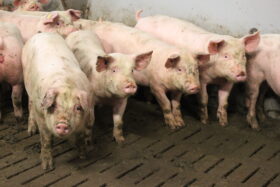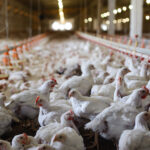By Predrag Persak, Regional Technical Manager Europe, EW Nutrition
Imagine you’re at a pub quiz dedicated to feed production, and this question pops up: name a process that returns up to 25 times what was invested in it. Do you know the answer? I’m pretty sure you are probably using it every day: pelleting. For every unit of used energy, pelleting generates up to 25 times more in terms of the nutritional value for animals (mostly metabolizable energy).
The math is simple: while we gain 200 kcal/kg by pelleting broiler mash feed, only 10 Kilowatts are used to produce one ton of broiler feed. This is just one example of how sustainability is at the core of feed production – and has always been, long before it became a buzzword. So, to all those who operate feed mills, who take care of sourcing and quality, and to those behind numbers that represent nutritional values: You are pioneers of sustainability and should be proud of that.
How feed processing can drive sustainability efforts
Besides being proud, we must also be very responsible. Every nutritionist should focus on
- how processing of feed materials and feed influences the release of nutrients, nutrient density, and exclusion of antinutrients, and
- how processing can improve these dimensions, making feed more sustainable.
Do we take processing sufficiently into consideration? Do we create formulations in a dynamic or more static way? Not least in an era of precision feeding, the shift from static to dynamic is inevitable.
This is even clearer when we consider how processing can influence digestion, absorption, and the performance of animals. How so? Feed processing makes previously unusable materials suitable for nutrition or improves already usable materials. So, the feed processing itself is a key to sustainability.
Feed processing converts energy into more energy (?!)
Feed processing, in simple terms, means converting energy into more energy. This shouldn’t work, given the law of thermodynamics, but it does. Compound feed contains various feed materials and additives. Grains and protein sources (many times wrongly declared as byproducts), fibrous roughages and many other different components should not go together. Thanks to processing, they become feed which ensures the availability of all nutrients to the species, category, or animal production system for which that feed is intended.

Through processing, we alter the physical, chemical, and edible properties of used feed materials, making them usable for animals. Through proper processing, we improve the digestibility of feed materials by up to 20%, enabling a more effective – and thus more sustainable – use of feed resources. In practice, there is room for improvement to make feed processing even more of a sustainability champion.
Moisture optimization is key to energy-efficient pelleting
Let’s take a closer look at pelleting since it requires the most energy within feed processing. How much energy is used? This depends on many factors and can range from 5 KW/h up to 25. Pelleting is mostly used in broiler diets to reduce nutrient segregation and feed sorting and, by extension, feed wastage. Pelleting has also been found to increase the weight gain of individual birds and flock uniformity, and overall feed efficiency is higher.
Pelleting involves the agglomeration of mixed feed into whole pellets through a mechanical process using heat, moisture, and pressure (Falk, 1985). Heat (energy that is transported through steam) has the largest impact on pelleting efficacy. Steam injected during conditioning increases feed moisture and temperature, softens feed particles, extracts natural binders, and reduces friction which leads to greater production rates and pellet quality (Skoch et al., 1981).
The key to an efficient pelleting process is to set the parameters at the levels that will enable proper energy transfer from steam to feed particles. Besides steam quality, the moisture of the feed is a critical factor for efficient energy transfer. Generally, the thermal conductivity of the most used feed materials increases with increasing moisture. A level of 17% moisture in the conditioner is needed for efficient energy transfer. Below 17%, we need more steam (more energy) or more time (more capacity) to achieve the same result. That is why proper moisture optimization is needed to use the energy transferred through steam in the most efficient way.
Reduce shrinkage, improve sustainability
What about shrinkage? Shrinkage is not just a cost factor but a sustainability issue. We must not lose scarce and valuable materials and nutrients. Overall shrinkage tends to be around 1%. For global feed production as a whole, 1% annual shrinkage is equivalent to 15 years of Croatian compound feed production!
We help our industry to keep up sustainability efforts in terms of energy savings and shrinkage reduction by offering SurfAce. It’s a liquid preservative premixture with multiple economic and environmental benefits to the customer. It helps increase pellet output, improves conditioning, enhances the durability of the pelleted feed, reduces the formation of fines, and improves the overall quality of the final feed product. But most importantly, it optimizes feed production costs through energy savings and reduced labor input while also supporting the microbiological quality of the feed.
In the food sector, we have seen vast improvements in non-thermal food processing over the past decade. Examples include ultrasonication, cold plasma technology, supercritical technology, irradiation, pulsed electric field, high hydrostatic pressure, pulsed ultraviolet technology, and ozone treatment. I’m sure some of these technologies will be applied to feed processing one day. Until then, we must keep up our high sustainability standards and make it more efficient by applying all available tools in our feed processing toolbox.
References
Falk, D. “Pelleting Cost Center.” Essay. In Feed Manufacturing Technology III, edited by Robert R. McEllhiney, 167–90. Arlington, VA: American Feed Industry Association, 1981.
Skoch, E.R., K.C. Behnke, C.W. Deyoe, and S.F. Binder. “The Effect of Steam-Conditioning Rate on the Pelleting Process.” Animal Feed Science and Technology 6, no. 1 (1981): 83–90. https://doi.org/10.1016/0377-8401(81)90033-x.
















